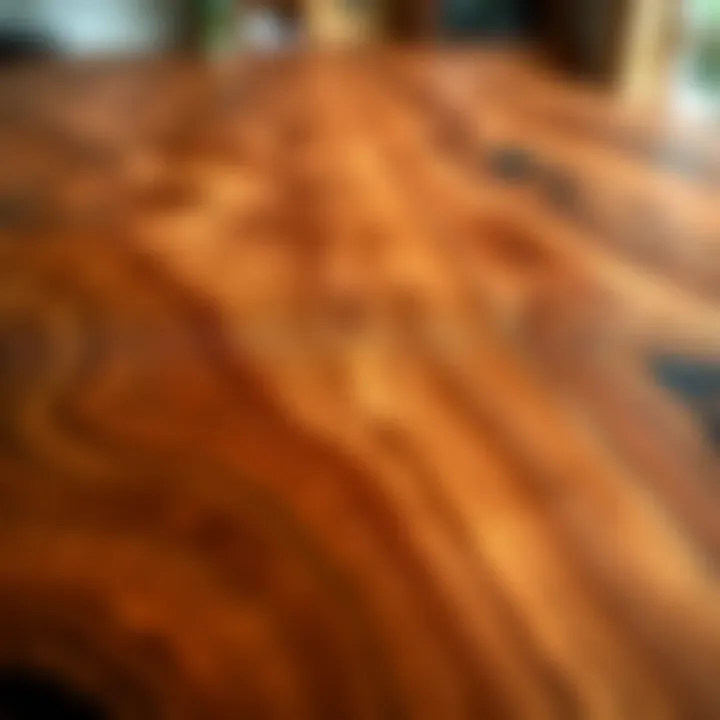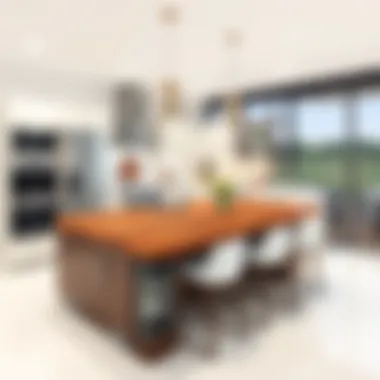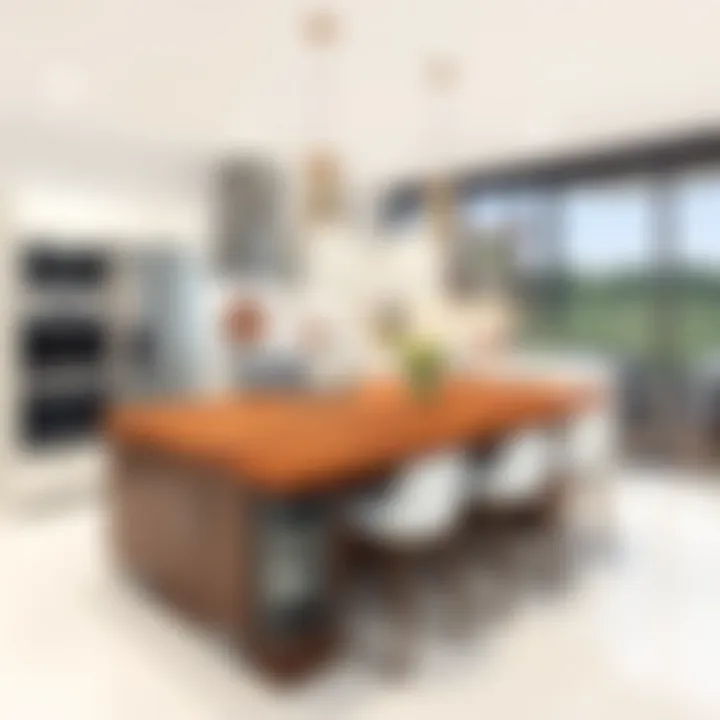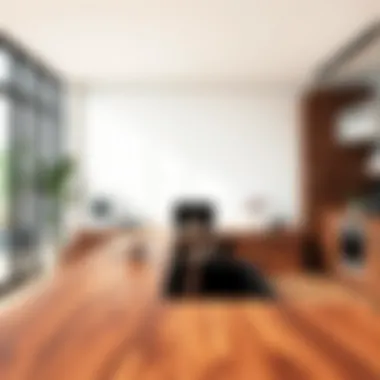Exploring Exotic Wood Countertops: Insights and Trends


Intro
In today's world, where functionality meets artistry, choosing the right countertop can greatly impact not only the aesthetic of a space but also its overall functionality. Exotic wood countertops, in particular, are turning heads for their unique patterns and rich textures. This article serves as a comprehensive look into these distinct surfaces, aiming to educate homeowners, designers, and DIY enthusiasts about the advantages, diverse materials, and essential care practices associated with exotic wood.
Unlike conventional options, exotic woods such as Teak, Mahogany, or Jatoba bring an element of nature inside while also offering substantial durability and beauty. With the rise in eco-conscious decisions and the pursuit of stylish spaces, understanding exotic wood countertops and their implications has never been more important.
As we explore different types, maintenance tips, and environmental considerations, let’s embark on this journey towards creating beautiful and sustainable interiors.
Furniture Design Insights
Designing a space involves a delicate balance between aesthetics and utility. Choosing wood types for countertops is no exception, especially when integrating them with other furniture in the room. Let's break down the intricacies involved in selecting and arranging these surfaces for optimal impact.
Understanding Style Preferences
When it comes to style, exotic wood can sway from modern minimalism to rustic charm. The selection of wood type can dictate the overall vibe of your room. For example, lighter woods like Bamboo might accentuate a contemporary aesthetic, while rich, dark woods like Wenge can evoke a sense of traditional warmth. Here are some considerations:
- Color Scheme: Make sure the countertop complements existing colors in your space. Pairing lighter woods with deep colors can create an eye-catching contrast.
- Texture and Grain: The visual appeal often lies in the unique grain patterns. For a smooth left behind, choose woods like Maple. For a more pronounced texture, options like Teak provide striking character.
Maximizing Space with Smart Layouts
A countertop isn't just a surface; it's a key player in your space's layout. Understanding how to make the most of your kitchen or workspace with the right arrangements can change the flow entirely.
- Zoning Areas: For kitchens, determine areas like food prep, cooking, and serving. Each can benefit from varied countertop heights or styles.
- Integrating Features: Consider built-in features like cutting boards or integrated sinks that can enhance functionality without sacrificing design.
Maintenance and Care Tips
Like an investment piece in your home, exotic wood countertops also require care to maintain their beauty and longevity. Knowing how to properly care for your countertop can save money and ensure sustained visual appeal.
Cleaning Techniques for Different Materials
Not all woods are created equal when it comes to cleanliness. Adopting the correct cleaning methods tailored to each wood type is essential:
- General Cleaning: Solution of mild soap and warm water works wonders for most woods. Use a sponge and wipe gently.
- For Oiled Surfaces: If your wood is treated with oil, consider a special wood cleaner to avoid damaging the finish.
- Avoid Harsh Chemicals: Always steer clear from bleach or ammonia-based products, as these can strip the wood’s natural oils.
Preventative Measures Against Wear and Tear
Once your countertop is in place, continuing care is paramount. Here are some smart preventative steps:
- Use Coasters and Cutting Boards: Protect the surface from hot pots and sharp knives.
- Regular Oiling: This keeps the wood hydrated and enhances its natural color and patterns. Make a habit of oiling your countertop every few months.
- Monitor Humidity: Wood expands and contracts; keeping the environment balanced can prevent cracking or warping.
Remember: The allure of exotic wood countertops is not only in their beautiful appearance, but also in how they adapt to your lifestyle.
By following these insights and tips, it's possible to create and maintain a countertop that not only serves as a functional surface but also stands as a centerpiece in your home.
For further reading, you can explore resources from @wikipedia.org, @homeadvisor.com, and specialized forums on @reddit.com.
Embracing exotic wood countertops opens doors across design possibilities while ensuring you make a responsible choice towards sustainability.
Foreword to Exotic Wood Countertops
Exotic wood countertops represent more than just a surface for meal prep or presentation; they embody the essence of craft, aesthetics, and sustainability. As kitchens and bathrooms evolve into personal sanctuaries, the choice of countertop material becomes crucial, not just for its functionality but for the character it brings into a space. Exotic woods offer a unique appeal that can transform a typical home environment into something extraordinary.
The discussion surrounding exotic wood countertops encompasses a range of perspectives that include their captivating beauty, durability, and environmental implications. Knowing their significance in home design, one might wonder why anyone would choose a superficial solution over a deeper one that merges form with function.
One of the most compelling reasons to consider these countertops lies in their unique characteristics. Unlike standard woods, exotic variations like teak or mahogany bring distinct patterns, colors, and textures that can act as a centerpiece for any room. They invite a tactile experience, drawing one’s hand across their natural finish to appreciate their grain. Moreover, when one opts for these surfaces, they are often acquiring a piece of art—no two slabs are precisely alike, which adds a layer of individuality to each installation.
The Benefits of Exotic Wood Countertops
- Aesthetic Value: The refinement and luxurious finish of exotic wood can enhance not only the kitchen but also living spaces and commercial environments, creating a welcoming atmosphere that resonates with sophistication.
- Durability: Many exotic woods are naturally resistant to wear and tear, which means these countertops can withstand the test of time with proper care. For instance, teak is known for its robust structure, making it suitable for high-traffic areas.
- Sustainability Considerations: When sourced responsibly, exotic woods can offer a sustainable alternative to traditional materials. This appeals to eco-conscious consumers who want to make informed choices in home renovations.
Highlighting essential elements such as the unique grain patterns, high durability, and eco-friendly sourcing practices paves the way for a comprehensive examination in this article. It will analyze not only the visual and practical facets but also the distinct feeling of luxury that exotic wood countertops provide.
In summary, the choice to explore exotic wood countertops positions oneself at the intersection of beauty and practicality. It serves to inspire designers, retailers, and homeowners alike to embrace a model of interior design that values artistry in daily life.
Defining Exotic Wood
In the realm of woodworking and interior design, the term "exotic wood" has a specific connotation, emerging from its unique characteristics that set it apart from more common varieties. The significance of understanding exotic wood is paramount in this exploration, as it encompasses various elements such as aesthetics, sustainability, and functionality, each of which plays a vital role in the decision-making process for designers, homeowners, and retailers alike.
Exotic woods are typically defined as species sourced from tropical and subtropical regions, and they can exhibit striking visual and physical properties. Familiarity with these woods can enable a better appreciation of their advantages and the considerations that come into play when choosing them for applications like countertops.
Characteristics of Exotic Wood
When it comes to characteristics, exotic woods stand out not just for their appearance, but also for their performance. Some key aspects include:


- Color Variety: Exotic woods often display a stunning spectrum of hues, from deep reds, rich browns, to vibrant yellows and greens, making them captivating choices for any space.
- Grain Patterns: Each species tends to have unique grain patterns, providing individual pieces with a distinctive design. Whether it’s the swirling patterns of a piece of tiger wood or the straight lines of mahogany, these visuals can enhance the overall décor significantly.
- Density and Weight: Many exotic woods, like teak and mahogany, are dense and heavy. This added mass usually translates into enhanced durability and resistance against wear and tear.
The interplay of these characteristics not only contributes to the functionality of countertops but also defines the overall ambience of any room.
Sources of Exotic Woods
Sourcing exotic woods is a complex topic that invites both beauty and controversy. The origins of these woods, typically found in forests across tropical regions, carry significant implications for sustainability and environmental conservation. Here are some important points to consider when looking at sources:
- Geographic Origin: Notable sources include Central and South America, Africa, and parts of Asia. Each region has unique species that offer their particular charm and functionality.
- Sustainable Practices: With heightened awareness of environmental issues, there is a growing emphasis on sustainable forestry. Utilizing woods from responsibly managed forests ensures a minimal ecological footprint.
- Legal Regulations: Awareness of legal harvesting practices is crucial. Many countries enforce strict regulations to prevent illegal logging that can harm both ecosystems and local communities. Familiarizing oneself with guidelines from organizations like the Forest Stewardship Council (FSC) can offer peace of mind when making a selection.
"Choosing to work with exotic wood responsibly ensures not just beauty in the present but sustains the ecosystems for future generations."
Understanding the sources of exotic wood and their characteristics enriches the dialogue around them, highlighting why they are favored resources in both design and function. Knowing where these materials come from can not only inform purchasing decisions but also inspire a deeper connection to the wood itself.
The Allure of Exotic Wood Countertops
The enchantment of exotic wood countertops cannot be understated. They stand not merely as functional surfaces but as statements of craftsmanship and attention to the beauty of nature. The intrinsic value of these countertops comes not only from their visual appeal but also from the stories they tell—each piece is unique, reflecting the culture and environment from which it originates.
One might wonder what makes these countertops so alluring in both residential and commercial settings. The answer lies in a medley of rich colors, striking grains, and textures that can transform an ordinary kitchen into a work of art. Functionality merges seamlessly with aesthetics, leading to a choice that is as practical as it is beautiful.
As we explore the allure further, we delve into three key aspects: aesthetic appeal, unique grain patterns and colors, and customization options that make these countertops highly desirable.
Aesthetic Appeal
The visual impact of exotic wood countertops is indisputable. They boast a range of colors from deep mahogany to bright bamboo, each contributing a distinct vibe. A kitchen featuring a vibrant teak wood countertop instantly radiates warmth, inviting friends and family to gather around. In contrast, a sleek walnut surface may convey sophistication and elegance.
Beyond color, the sheen and finish of these woods enhance their beauty. A well-polished surface reflects light in ways that highlight the natural characteristics of the wood. The rich textures and patterns can match various home styles—be it rustic, modern, or somewhere in-between, offering versatility in design choices.
Unique Grain Patterns and Colors
Every piece of exotic wood tells its own story through unique grain patterns. These grains can range from straight and uniform to wildly swirling and chaotic. The patterns not only serve a visual function but also affect the wood's durability and performance. For example, a counter made from Zebrano or Zebrawood showcases stripes that resemble the animal from which it takes its name; this creates a striking conversation starter in any kitchen.
Moreover, the variety of colors in these woods is impressive. The ambrosia maple features striking contrasts with rich blues and greens alongside natural wood tones, while wenge can introduce a deep, dark aesthetic that anchors a space. This mélange of colors and patterns makes it impossible for two countertops to look alike—each surface is a one-of-a-kind treasure.
Customization Options
The allure of exotic wood countertops extends into the realm of personalization. Designers and homeowners alike appreciate the ability to customize these surfaces according to specific requirements—whether it’s fitting an odd-shaped kitchen island or choosing a desired finish. Different edge profiles, such as eased or beveled edges, can be selected to match the kitchen's design theme.
Furthermore, options for finishes can dramatically alter the look and feel of the wood. A matte finish provides a rustic charm that highlights natural imperfections, while a glossy finish brings out the hues and creates a stunning reflective quality. You can choose how much shine you want based on personal preference and the overall ambiance of the space.
"The essence of craftsmanship lies in the details—each unique piece of wood, chosen thoughtfully, enhances the overall narrative of a designed space."
With such dynamic options available, exotic wood countertops are not merely installations but extensions of personal style and expression.
Types of Exotic Wood Used in Countertops
The choice of exotic wood used in countertops is paramount, bringing not just aesthetic qualities but also functional performance to the forefront. Each type of wood carries its unique benefits and considerations, creating a landscape of options for homeowners and designers alike. The four prominent types of exotic woods—teak, mahogany, walnut, and bamboo—each exhibit distinct characteristics that speak to varied tastes and purposes. Understanding these nuances will guide you in making a well-informed decision, whether you are redecorating a kitchen or creating an inviting workspace.
Teak: Durability and Resistance
Teak wood is often lauded for its impressive durability and resistance to various elements. This particular type of wood comes from tropical regions, predominantly Southeast Asia. What sets it apart is its natural oils that make it resistant to moisture and warping, a crucial characteristic for kitchen environments where spills are just part of daily life. Additionally, teak’s natural resistance to pests means that even in damp conditions, it remains unharmed.
- Key Benefits:Investing in teak countertops can mean less worry about maintenance, as regular sealing isn't always necessary. However, one should note that quality teak comes with a higher price tag due to the scarcity resulting from unsustainable harvesting practices in previous decades. It’s vital to source teak responsibly.
- Resilient to moisture and humidity
- Offers a rich, golden appearance over time
Mahogany: Timeless Elegance
Mahogany exudes a sense of elegance and sophistication that is difficult to match. This hardwood is often sourced from Central and South America and is characterized by its deep, reddish-brown color, which deepens over time, imparting a rich, luxurious look. The smooth grain of mahogany lends itself well to various styles, from classic to contemporary.
- Key Benefits:Mahogany’s finish can speak volumes about the overall ambiance of a space. It's one of those materials that can elevate a room instantly. However, it is less durable compared to teak and may require additional attention in maintenance, especially in areas prone to water exposure. Yet, for many, the sheer beauty of mahogany is an irresistible lure.
- Stunning color and grain pattern
- Easy to work with for custom designs
Walnut: Rich Depth and Versatility
Walnut wood, with its deep tones and various textures, brings a sense of depth to countertops. This American hardwood features rich brown hues often with striking dark and light contrasts, showcasing a natural elegance. Walnut's strength and ability to take on intricate cuts make it a versatile choice for both traditional and modern kitchens.
- Key Benefits:The impact of walnut on a space is significant; it can balance warmth with sophistication. Walnut countertops can be oiled or sealed to prolong their life, and they can work well with various cabinet styles. One should consider pairing walnut with lighter cabinetry to highlight its beautiful tones effectively.
- Strong and durable yet flexible in design
- Offers a unique, attractive grain pattern
Bamboo: Sustainability Meets Style


Bamboo, although technically a grass, is making waves in the world of exotic wood countertops. It is one of the most sustainable materials available due to its rapid growth rate. Bamboo can be harvested every 3 to 5 years, making it a responsible choice for environmentally conscious consumers.
- Key Benefits:Its light color and clean lines appeal to those looking for contemporary styles without sacrificing sustainability. Bamboo also has natural resistance to bacteria and moisture, making it a practical option for kitchen countertops. While it may lack the depth of color found in traditional hardwoods, its beauty lies in minimalism and chic simplicity.
- Eco-friendly and sustainable
- Unique aesthetic with a modern edge
Functional Benefits of Exotic Wood Countertops
The decision to adorn your kitchen or workspace with an exotic wood countertop goes beyond mere aesthetics. In an age where practicality often meets elegance, these surfaces offer a marriage of functionality and beauty that is hard to overlook. This section dives into the key benefits that investing in exotic wood countertops can bring to your daily life, showcasing how they can enhance not only the visual appeal of your space but also its usability.
Durability and Longevity
One of the standout features of exotic wood countertops is their remarkable durability. Woods like teak and mahogany, crafted under natural conditions over countless years, showcase a resilience that can resist scratches, dings, and more. While everyday materials might buckle under pressure, exotic woods simply bounce back, making them perfect for busy kitchens where spills and rough usage abound.
Not to mention, choosing high-quality materials means you’re investing in longevity. A well-maintained exotic wood countertop can last for decades, standing as a testament to superior craftsmanship.
"A high-quality countertop can turn your kitchen into an area that not only functions well but feels inviting too."
Natural Resistance to Bacteria
The inherent characteristics of many exotic woods make them favorable in terms of hygiene. For instance, woods like bamboo and teak possess natural oils that help prevent bacterial growth. This is not just an aesthetic boon but a significant functional advantage, especially in food preparation areas. With a surface that actively resists pathogens, exotic wood countertops can offer peace of mind, allowing you to focus on cooking without worrying about bacteria lurking in unseen crevices.
Additionally, unlike synthetic surfaces that may harbor hidden bacteria if not cleaned properly, the porous nature of wood can actually help in maintaining cleaner surfaces when treated well.
Thermal Properties
Exotic wood countertops also come with favorable thermal properties. They are well-known for their ability to resist heat, which proves especially useful in kitchens where hot pots and pans often meet work surfaces. Unlike laminate or certain types of stone that can crack or scorch, a well-crafted exotic wood surface can often withstand high temperatures from a sizzling skillet.
While no surface is entirely foolproof, with careful maintenance—such as using trivets and avoiding direct prolonged heat contact—exotic wood can serve reliably in playful cooking scenarios. This thoughtful balance between beauty and functionality makes these countertops revered by chefs and home cooks alike.
In creating a culinary space, exotic wood countertops stand not only as a showpiece but also enhance the daily practice of cooking and entertaining.
Considerations When Choosing Exotic Wood Countertops
Choosing exotic wood countertops is about more than just aesthetics; it’s also a thoughtful process involving a variety of factors. Engaging with this aspect significantly impacts the long-term satisfaction and functionality of the surface you will use in your home or workspace. To make an informed decision, it's crucial to consider several dimensions: cost, sourcing practices, and the compatibility with existing design elements in your space.
Cost Factors
When it comes to cost, exotic wood countertops can vary widely. The price is often dictated by the type of wood, its rarity, and the craftsmanship involved in shaping and finishing it. For instance, premium materials like African Mahogany or Teak will generally command a higher price tag compared to more common varieties.
It's also essential to account for installation expenses, maintenance over time, and any potential repairs that may arise. Here are some points to ponder:
- Materials and Rarity: The more unique the wood, the higher the cost typically will be.
- Workmanship: Countertops that require extensive handwork or intricate designs will escalate your overall investment.
- Long-term Value: Weigh the initial cost against durability and lifespan. High-quality exotic woods can last a lifetime, making them a worthy investment.
"Investing in a quality countertop today can save you money in the long run."
Selecting a countertop should feel like a well-calibrated balancing act between your budget and your desire for a stunning final result.
Sourcing Responsibly
In today’s environmentally conscious climate, sourcing wood responsibly is pivotal. A variety of organizations advocate for sustainable forestry practices, ensuring your time spent in selecting wood doesn’t contribute to ecological degradation. Ensuring that your exotic wood is sourced from certified forests can directly affect:
- Sustainability: Practices like selective logging allow forests to regenerate over time, maintaining biodiversity.
- Certification: Look for certified woods that meet standards from organizations such as the Forest Stewardship Council (FSC).
- Impact on Ecosystems: Responsible sourcing minimizes negative ecological impacts and supports local economies.
Being proactive about where and how your wood is sourced not only leads to a more sustainable choice but can also enhance its story — giving greater value to your investment.
Compatibility with Home Design
An exotic wood countertop should seamlessly fit into your existing home design. Consider the overall aesthetic and the emotional vibe you aim to create. Exotic woods come in a vast palette of colors and grain patterns, from rich dark hues to lighter, more neutral tones. Here’s what to examine when considering compatibility:
- Color Matching: Does the wood align with other elements in your kitchen or bathroom? Think cabinetry, flooring, and wall color.
- Texture: A smooth finish reflects modern minimalism, while a more rustic texture may suit a farmhouse aesthetic.
- Layout: Evaluate how the countertop interacts with other surfaces. An overly heavy-looking wood may overwhelm a small space, while too light a finish can look washed out in larger areas.
Choosing an exotic wood countertop is not just about function — it also reflects your personal style and complements your living environment. By keeping these considerations in mind, you’ll find a piece that is stylish, sustainable, and timeless.
Maintenance of Exotic Wood Countertops
Proper maintenance of exotic wood countertops is essential for long-term performance and aesthetics. Unlike synthetic materials, these countertops require specific care that honors the natural beauty and qualities of the wood. Neglecting their upkeep can lead to a faster deterioration of the surface, ultimately compromising both functionality and appearance. The importance of maintenance cannot be overstated, as regular care not only extends the life of the countertops but also maintains their striking visual appeal.
Cleaning Techniques
Cleaning exotic wood countertops involves a mix of simple methods and specific products to ensure the longevity of the finish. It’s crucial to use a mild soap solution—opt for a gentle dish soap mixed with water. This solution helps keep the surface free from dirt and bacteria.
- Use a soft cloth: Always employ soft cloths or microfiber towels to wipe down your countertops. Avoid anything abrasive, as it may scratch the wood.
- Wipe spills immediately: Don’t let spills linger. Wiping them up quickly prevents staining and moisture absorption.
- Avoid soaking: While it is tempting to use plenty of water, soaking the wood can cause warping or damaging. Instead, use a damp cloth and dry immediately.
Remember: Regular cleaning not only helps maintain cleanliness but also preserves the wood’s natural oils, which are crucial for its resilience.


Sealing and Finishing Options
Sealing exotic wood countertops is an essential part of maintenance, as it provides a protective barrier against moisture and stains. Selecting the right finish is vital for preserving the wood’s beauty and functionality in a kitchen or bathroom environment.
- Types of finishes: Polyurethane, varnish, and mineral oil are commonly used. Each offers different levels of durability and ease of maintenance.
- Frequency of sealing: Depending on the finish chosen, countertops may need resealing every six months to a year. Regularly check for wear or areas where the finish may be thinning.
- Application method: Follow the manufacturer's instructions carefully. This typically includes sanding the surface lightly before applying the sealant, ensuring a smooth and effective bond.
Repairing Scratches and Dents
Although exotic wood countertops are robust, they may sometimes suffer from scratches or dents. These imperfections can detract from the overall look of the countertop, but they can often be repaired with minimal effort.
- Minor scratches: For light scratches, a simple blend of olive oil and vinegar can work wonders. Apply the mixture with a soft cloth, buffing it in to enhance the wood’s natural color.
- Deeper dents: For deeper scratches or dents, you may need to use a wood filler that closely matches the countertop’s color. After applying the filler, sand it down to ensure a flush finish.
- Maintain periodic care: Beyond repairs, regularly conditioning the surface with natural oils can help prevent damage and keep the wood looking rich and vibrant.
In summary, maintenance is not just a chore; it's an investment. By establishing a routine care pattern, exotic wood countertops can bring warmth and beauty to your home for years to come.
Environmental Impact of Exotic Wood Sourcing
The term exotic wood conjures images of luxurious grains and standout aesthetics, but it also brings forth a vital conversation about its environmental impact. As more households and businesses lean towards these unique materials, understanding the ethical implications and sustainability of sourcing becomes crucial. The journey from forest to countertop has ramifications that echo within the ecosystem, making it necessary to tread carefully through this ornate terrain. An informed choice can lead to outcomes that preserve both beauty and biodiversity.
Sustainable Forestry Practices
Sustainable forestry practices represent the cornerstone of responsible exotic wood sourcing. These methods ensure that wood is harvested in a way that maintains the health of forest ecosystems, supporting the flora and fauna that rely on these habitats. The Forest Stewardship Council (FSC) certification is one beacon of hope. It highlights wood products sourced with a cautionary eye, upholding standards that promote responsible management of forests worldwide.
Think of sustainable practices as a balance act, where the need for timber doesn’t overshadow environmental stewardship. Rather, it pairs with reforestation efforts, innovative logging techniques, and support for local communities. When you buy countertops made from FSC-certified wood, you’re backing a system that prioritizes long-term planetary health over short-term gains.
"Choosing wood is not just about aesthetics; it’s about heritage, sustainability, and ensuring the next generation can enjoy our natural resources."
Additionally, technology is playing a role as well. The integration of remote sensing and drone technology helps monitor deforestation levels and biodiversity, ensuring that timber extraction proceeds without substantial ecological degradation. With these practices, one can confidently choose exotic wood without sacrificing the health of our planet.
Emission Considerations
When diving into the world of exotic wood, it's not just about the trees. There's a broader view where carbon emissions come into play. Each step in the wood industry, from logging to transportation, generates a footprint that can impact climate change. The old adage, "what goes up must come down," rings especially true here—particularly concerning carbon emissions contributing to the greenhouse effect.
Exotic woods, often imported over long distances, are particularly guilty of high emissions related to transportation. This reality raises questions about local alternatives or sourcing methods that can mitigate these emissions. An emerging focus is on reducing carbon footprints through local sourcing initiatives or even plantation-grown options which may offer a viable solution.
Moreover, using eco-friendly adhesive and finishing agents during the manufacturing process also lessens emissions. Opting for manufacturers who prioritize low-VOC (volatile organic compounds) products can significantly diminish hazardous atmospheric impacts. As awareness grows, consumers have a role to play, demanding transparency and eco-conscious choices in their specifications for countertops.
Taking a closer look at carbon neutrality in the wood industry is more than just a timely trend; it is a necessary step toward a balanced ecological relationship. Every responsible choice we make ripples through the environment, marking the difference between mere aesthetics and sustainable beauty.
Trends in Exotic Wood Countertop Designs
As the world of interior design evolves, a notable shift has emerged towards the incorporation of exotic wood countertops in modern kitchens and living spaces. These surfaces have become more than just functional work areas; they are now essential elements of design that fuse aesthetic appeal with practicality. Embracing these trends can elevate a home’s visual narrative and ensure it stands out from the crowd.
Several key factors have played a significant role in shaping the current trends surrounding exotic wood countertops. Firstly, homeowners and designers alike are acknowledging the importance of sustainable practices. With the growing awareness of environmental issues, many look for sources that not only supply trendy materials but do so responsibly. Moreover, the push towards unique designs encourages a departure from traditional materials like granite or laminate, offering a fresh perspective through rich woods with distinctive patterns and hues.
Modern Interpretations
The modern interpretation of exotic wood countertops showcases a striking balance between tradition and innovation. Designers are steering away from uniformity and are instead exploring the extraordinary variability that exotic woods offer. For instance, woods such as zebrano or sandalwood are gaining traction due to their unique grains and warm tones. This shift embraces natural imperfections, embracing knots and other features that tell a story of their origins. In a time when consumers crave authenticity, these surfaces highlight both their material’s environmental background and unique aesthetic.
Some noteworthy aspects include:
- Natural Finishing: Many modern designs are opting for natural, oil-based finishes that enhance the wood’s character while ensuring it remains eco-friendly.
- Layering Textures: Mixing wood with metals or stone carries the idea of creating depth in spaces, leading to dynamic kitchens that feel both cozy and contemporary.
- Integrated Features: Incorporating elements like seamless sink designs or embedded cutting boards further elevate the functionality of these countertops without compromising design aesthetics.
Integrating Technology
Integrating technology into the design of exotic wood countertops is not just about aesthetics but also elevating practical usability. With the advent of smart home technologies, countertops are becoming smarter too. For example, touch-sensitive surfaces can help you control lighting or appliances with a simple touch. This fusion of technology with exotic wood begins to form a new genre of luxury in kitchen design.
Consider the following advancements:
- Embedded Sensors: These can monitor the temperature of food or alert users when a cutting board is not sanitized properly, marrying health with convenience.
- Smart Finishes: New coatings are being developed that not only protect wood from stains and water damage but also offer self-cleaning properties.
- Lighting Integration: Subtle lighting under or atop the countertops can enhance the wood's natural beauty, creating a captivating play of light and shadow, while also providing functional illumination for cooking tasks.
"The countertop serves as the heart of modern kitchens; integrating exotic wood with technology redefines the culinary experience."
In summary, the trends in exotic wood countertop designs reflect a growing commitment to sustainability, individuality, and innovation. With a focus on modern interpretations that respect the material’s origins and a keen eye toward incorporating tech advancements, these countertops have secured their place as a cornerstone of contemporary interior design.
The End: The Future of Exotic Wood Countertops
Considering the intricate tapestry surrounding exotic wood countertops, their future appears promising yet layered with challenges. As more homeowners and designers lean towards unique materials with both aesthetic and functional qualities, the demand for these countertops is likely to escalate. However, this rise must be accompanied by a responsible approach to sourcing and sustainability.
When looking at exotic woods, we must recognize their allure stems not just from appearance but also from the story each piece tells. For instance, a rich, dark mahogany slab can evoke a sense of heritage and sturdiness, while lighter bamboo options communicate a modern touch with their sustainable credentials. Therefore, as trends evolve, there is a shift towards marrying beauty with ethical practices.
A few key points to ponder include:
- Sustainability in Sourcing: The future hinges on how companies handle sourcing. Consumers are becoming increasingly conscientious about the environmental impact of their purchases. By choosing providers who engage in sustainable forestry practices, we help ensure that the majestic forests remain intact for generations to come.
- Innovation in Design: As technology progresses, so do the techniques and processes used in crafting these countertops. Laser cutting and advanced finishing methods allow for endless customization options, enabling clients to personalize their spaces in ways that were previously unimaginable. This demand for personalization plays into a larger narrative of individual expression in home design.
- Education and Awareness: Finally, it will be crucial to educate consumers on the importance of maintaining exotic woods. Proper care—such as regular sealing and conscientious cleaning—extends the life of these investments and maintains their beauty. As more individuals understand these care requirements, they will be better equipped to make informed decisions balancing luxury with longevity.
The allure of exotic wood countertops is undeniably powerful. Yet, it is imperative that its future is grounded in sustainability and ethical practices to preserve these beautiful resources and enrich our living spaces.
In sum, the future of exotic wood countertops rests on our shoulders as stewards of the environment. By navigating choices with awareness and care, the next generation of homeowners and designers can revel in the beauty of these luxurious materials while ensuring they remain available for years to come.
For anyone considering this material, it's crucial to engage with suppliers and manufacturers who emphasize environmentally friendly practices while delivering quality. Resources like the Forest Stewardship Council ( https://www.fsc.org/) can offer guidance in identifying sustainably sourced materials.















